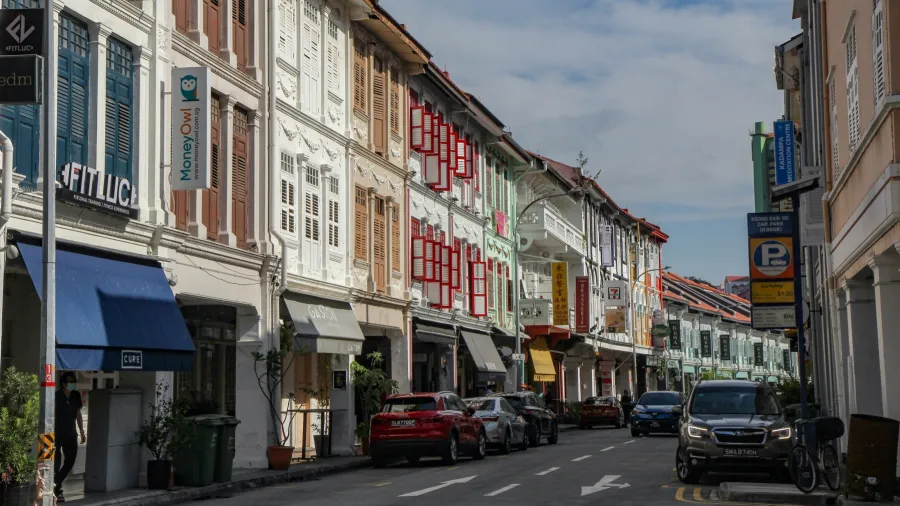
Millionaires eye a piece of Singapore’s rich colonial era
The city-state’s remaining 6,500 shophouses are in high demand amongst the ultra-rich.
The ultra-rich are in a buying frenzy for shophouses in Singapore as they crave for a slice of the city-state's colonial history, with a potential for solid returns.
With only 6,500 shophouses — most of them built between the 1840s and 1960s to serve as a dwelling and retail space in one structure — remaining, they are in high demand.
“Going by the logic of supply and demand, the supply is limited, it is finite, and the demand for it is very high,” Kevin Chia, assistant senior director at OrangeTee & Tie, told Singapore Business Review. So that makes it rare to actually have it, and people are willing to pay good money for that.”
Whilst shophouse sales in the former British colony continued to slow in the first half of 2024 to 40 units worth $354m from 79 units worth $728.9m a year earlier, according to Knight Frank, they remain attractive investments.
“We see a lot of law firms, audit firms, and IT (information technology) firms coming to shophouses to use them as an office… because of the flexibility in terms of operating hours,” said Jeremy Lim, executive group district director at Huttons Asia.
He noted that shophouses are part of the city-state’s heritage and are conserved by the Urban Redevelopment Authority, making them premium real estate.
Every five years, government authorities check up on the buildings to make sure that they are properly maintained. End-users are barred from doing illegal alterations on the buildings, and any renovations inside and outside the property must be state-approved.
“There is prestige in owning shophouses, and most of them are located at very ideal locations.” Lim said, adding that they are likely to hold their value much longer. Their popularity is also spurred by famous people acquiring shophouses in Singapore.
The wife of Chinese billionaire Jack Ma bought three adjoining shophouses at Duxton Road, Mingtiandi reported in February. Zhang Ying paid $45m to $50m, it said, citing public records.
“There are tycoons all over the world like Ricardo Portabella and [investor] Ray Dalio, and they have bought shophouses,” Chia said.
“A lot of times, these things are reported in the news elsewhere in the world. And when foreigners see that, they also want to get a taste of it. [They think] ‘They must be doing something or know something that I don’t,’” he added. Because shophouses are commercial properties, foreigners need not pay an additional buyer’s stamp duty. Singapore banks also offer better loan deals for these properties.
“Banks are more willing to lend for Singapore properties, interest rates are definitely more favourable than places like Malaysia and Indonesia, and the Singapore dollar has been very stable in recent years, more so than neighbouring currencies,” said John Bin, director of Capital Markets and Investment Services at Colliers.
But high interest rates in recent years have forced some of these rich people to pay in cash, he pointed out. Most of them invest in shophouses for their investment potential and to preserve capital, he added.
True value
Bin said investing in shophouses could be quite low-yielding at first, and could even lead to a shortfall after interest payments. “So in terms of cash flow, it may not be that attractive, but it's more for capital preservation and increased value down the line.”
Chia said the main investment motivation for ultra-rich people who are into shophouses is the investment potential. “There is a small number [who] buy [shophouses] as a trophy [and] they are not worried about how much return they get. Most people would be more concerned about the dollar and cents.”
Shophouses in Singapore were once overlooked and undervalued.
"Ten years ago, they weren’t as popular because foreigners and locals who [were] not active in this market would think, ‘Why does a shophouse cost $30m, $40m, $50m, or even up to $80m, [costing] more than a GCB (good class bungalow), when it's much smaller?’” Lim said.
Sales of shophouses fell to their lowest quarter in 13 years in Q4 2023, after more than a dozen of them were linked to Singapore’s biggest money laundering case involving $3b. Police in August last year arrested and charged at least 10 suspects, two of whom had used the properties as collateral for loans.
“The police put several shophouses on hold for the investigation,” Bin said. “So investors were a bit hesitant and were waiting for the outcome of the police investigation and what would happen to those shophouses.”
Chia noted that because some banks had helped police in the probe, they became stricter in their background checks, which made it harder to buy shophouses. “Sometimes, as a buyer, you just get very fed up and decide not to buy.”
Chia said most buyers initially overlook commercial assets because their priority is securing a roof over their heads, leading them to invest in residential properties first.
It wasn't until the government emphasised preserving shophouses and buyers realised their prime locations that their true value became apparent.
“Because of a lack of information and maybe a fear in investing in something unknown, shophouses [were] under the radar for many, many years,” Chia said. Then people realised it’s not worth it to pay for additional buyer's stamp duty.
Over time, investors realised that the demand for these properties, along with their capital appreciation and rental returns, was strong, spurring demand. Aside from location, shophouse investors see value in freehold shophouses and those with food and beverage (F&B) licences.
“Places in very prime locations like Tanjong Pagar, Craig Road, Duxton, Neil Road, Tras Street — these are some of the very popular locations where tenure is only probably about 65 to 67 years [and these places have higher] quantum,” Lim said.
“In fact, we do have some tenants from the central business district area who used to be renting very premium, very high-end offices, paying high quantum money [and] they are shifting,” he said. “They buy shophouses and use it themselves.”
Chia said the ultra-rich typically only want to own shophouses at prime locations, and would aim for Districts 1, 2, and 3 in the central business district area, Boat Quay, Chinatown, and Havelock Road.
But some investors have increasingly shown interest in areas outside these prime districts, where shophouses are cheaper, and especially after a government ban on red light districts and alcohol restrictions.
“They are becoming more savvy,” Chia said. “They know there are better districts out there,” including Bugis, District 15, including East Coast and Marine Parade, and Districts 8, 12, and 14, which cover the Little India area, Balestier, and Geylang, respectively.



















 Advertise
Advertise







